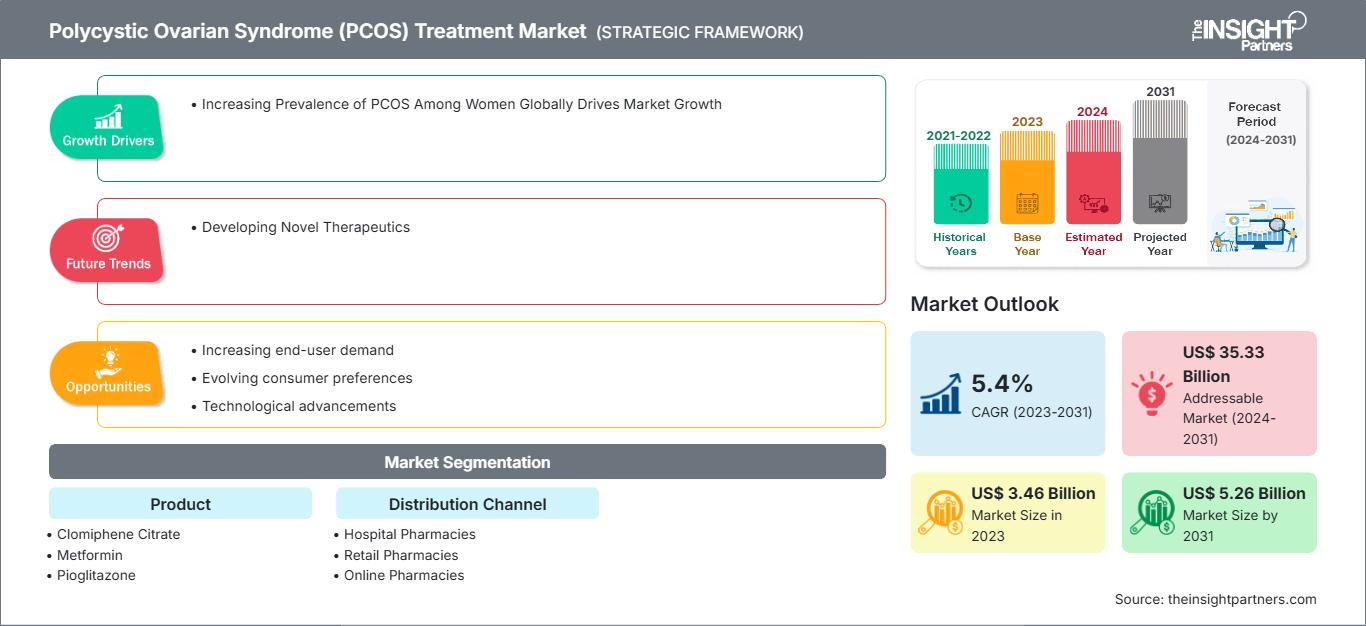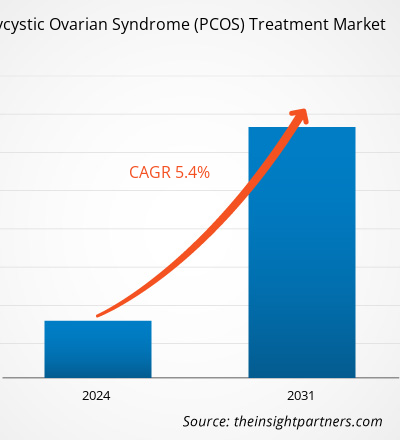Si prevede che il mercato dei trattamenti per la sindrome dell'ovaio policistico (PCO) raggiungerà i 7,48 miliardi di dollari entro il 2031. Si prevede che il mercato registrerà un CAGR del 5,8% nel periodo 2025-2031.
L'aumento della prevalenza della PCOS a livello globale, unito a un aumento significativo della spesa sanitaria per il trattamento della PCOS , sono i fattori che spingono la crescita del mercato dei trattamenti per la sindrome dell'ovaio policistico ( PCOS ). Ad esempio, circa 6 milioni di donne negli Stati Uniti soffrono di PCOS , uno squilibrio ormonale comune. Aumenta il rischio di diverse malattie, come il cancro dell'endometrio, l'ipertensione, il diabete di tipo 2, l'infertilità e l'ictus. Inoltre, l'Endocrine Society stima che la diagnosi e il trattamento della sindrome dell'ovaio policistico ( PCOS ), il disturbo ormonale più diffuso tra le donne in età riproduttiva, costerà 8 miliardi di dollari a livello nazionale nel 2020.
Lo sviluppo di nuove terapie porterà nuove tendenze nel mercato dei trattamenti per la sindrome dell'ovaio policistico ( PCOS ) durante il periodo di previsione.
Fattori di crescita:
La crescente prevalenza della PCOS tra le donne a livello globale stimola la crescita del mercato dei trattamenti per la sindrome dell'ovaio policistico ( PCOS )
La sindrome dell'ovaio policistico ( PCOS ) è un disturbo endocrino multifattoriale comune tra le donne. Secondo l'Organizzazione Mondiale della Sanità (OMS), la PCOS colpisce circa l'8-13% delle donne in età riproduttiva. A livello globale, la PCOS è la causa più comune di anovulazione e una delle principali cause di infertilità. Inoltre, circa il 70% delle donne affette da PCOS non viene diagnosticata . Uno stile di vita scorretto, una dieta scorretta e alcuni fattori ambientali possono causare la PCOS . L'obesità è un importante fattore di rischio per la PCOS , poiché l'eccesso di grasso corporeo può alterare i livelli ormonali e la sensibilità all'insulina, portando allo sviluppo della condizione. Con l'epidemia globale di obesità in aumento, sempre più donne sono a rischio di sviluppare la PCOS . Secondo il World Obesity Atlas 2022 della World Obesity Federation, entro il 2030, più di un miliardo di persone in tutto il mondo saranno affette da obesità, tra cui 1 donna su cinque.
Inoltre, la crescente prevalenza della PCOS ha portato a una crescente domanda di opzioni terapeutiche efficaci. Sono disponibili vari trattamenti farmacologici e non farmacologici per la PCOS , volti a regolare i livelli ormonali, migliorare la sensibilità all'insulina e affrontare altri fattori sottostanti che contribuiscono alla PCOS . Pertanto, la crescente prevalenza della PCOS tra le donne a livello globale guida la crescita del mercato dei trattamenti per la sindrome dell'ovaio policistico ( PCOS ).
Contenimento:
La disponibilità limitata di farmaci approvati dalla FDA specificamente per la PCOS ostacola il mercato del trattamento della sindrome dell'ovaio policistico ( PCOS )
La disponibilità di farmaci approvati dalla Food and Drug Administration (FDA) specificamente progettati per affrontare i sintomi complessi e gli squilibri ormonali sottostanti associati alla sindrome dell'ovaio policistico ( PCOS ) è limitata. Nonostante l'elevata prevalenza della PCOS e il suo impatto significativo sulla salute, la fertilità e la qualità della vita delle donne, sono relativamente poche le opzioni farmaceutiche (farmaci off-label) approvate dalla FDA per il trattamento di questa condizione. La mancanza di farmaci approvati dalla FDA rappresenta una sfida per gli operatori sanitari e le pazienti che cercano trattamenti efficaci e basati sull'evidenza per la PCOS . Sebbene l'uso off-label di alcuni farmaci come contraccettivi orali, agenti insulino-sensibilizzanti e antiandrogeni sia comune nella gestione dei sintomi della PCOS , l'assenza di terapie dedicate limita la capacità di affrontare la condizione in modo completo. Pertanto, la disponibilità limitata di farmaci approvati dalla FDA specificamente indicati per la PCOS frena la crescita del mercato dei trattamenti per la sindrome dell'ovaio policistico ( PCOS ).
Riceverai la personalizzazione gratuita di qualsiasi report, incluse parti di questo report, analisi a livello nazionale, pacchetto dati Excel e potrai usufruire di fantastiche offerte e sconti per start-up e università.
Mercato dei trattamenti per la sindrome dell'ovaio policistico ( PCOS ): approfondimenti strategici

- Scopri le principali tendenze di mercato di questo rapporto.Questo campione GRATUITO includerà analisi dei dati, che spaziano dalle tendenze di mercato alle stime e alle previsioni.
Segmentazione e ambito del report:
L'analisi di mercato del trattamento della sindrome dell'ovaio policistico (PCOS) è stata condotta prendendo in considerazione i seguenti segmenti: prodotto e canale di distribuzione.
Per prodotto, il mercato dei trattamenti per la sindrome dell'ovaio policistico (PCOS) è segmentato in clomifene citrato, metformina, pioglitazone, contraccettivi orali e altri. Il segmento della metformina ha detenuto la quota di mercato maggiore nel 2023. Inoltre, si prevede che il segmento del clomifene citrato registrerà il CAGR più elevato durante il periodo di previsione.
Il mercato dei trattamenti per la sindrome dell'ovaio policistico (PCOS), per canale di distribuzione, è suddiviso in farmacie ospedaliere, farmacie al dettaglio e farmacie online. Il segmento delle farmacie ospedaliere ha detenuto la quota di mercato più ampia per i trattamenti per la sindrome dell'ovaio policistico (PCOS) nel 2023 e si prevede che registrerà il CAGR più elevato durante il periodo di previsione.
Analisi regionale:
In termini geografici, l'ambito del rapporto sul mercato dei trattamenti per la sindrome dell'ovaio policistico (PCOS) include Nord America, Europa, Asia-Pacifico, America meridionale e centrale, Medio Oriente e Africa. Nel 2023, il Nord America deteneva la quota di mercato maggiore. La crescente adozione delle più recenti tecnologie di dispositivi medici, la crescente prevalenza della PCOS e le crescenti innovazioni di prodotto da parte dei principali attori contribuiscono alla crescita del mercato dei trattamenti per la sindrome dell'ovaio policistico (PCOS) in Nord America. Secondo il Dipartimento della Salute e dei Servizi Umani degli Stati Uniti, la PCOS è una causa comune di infertilità femminile negli Stati Uniti, che colpisce circa il 6-12% (circa 5 milioni) delle donne statunitensi in età riproduttiva. Secondo lo studio "Incidenza, prevalenza e tendenze nella diagnosi della sindrome dell'ovaio policistico", pubblicato a luglio 2023 sull'American Journal of Obstetrics and Gynecology, il tasso di incidenza della PCOS negli Stati Uniti è di 42,5 casi ogni 10.000 persone ogni anno. Inoltre, diverse organizzazioni nel paese offrono valutazioni complete, sensibilizzano e si concentrano sulla ricerca relativa alla PCOS. Ad esempio, l'UCSF Center for Reproductive Health è attivamente impegnato nella ricerca per studiare le cause della PCOS. Pertanto, l'elevata prevalenza della PCOS e la presenza di organizzazioni focalizzate sulla ricerca e sulla sensibilizzazione favoriscono la crescita del mercato dei trattamenti per la sindrome dell'ovaio policistico (PCOS).
Approfondimenti regionali sul mercato dei trattamenti per la sindrome dell'ovaio policistico (PCOS)
Le tendenze regionali e i fattori che influenzano il mercato dei trattamenti per la sindrome dell'ovaio policistico (PCOS) durante il periodo di previsione sono stati ampiamente spiegati dagli analisti di The Insight Partners. Questa sezione illustra anche i segmenti e la geografia del mercato dei trattamenti per la sindrome dell'ovaio policistico (PCOS) in Nord America, Europa, Asia-Pacifico, Medio Oriente e Africa, America meridionale e centrale.
Ambito del rapporto di mercato sul trattamento della sindrome dell'ovaio policistico (PCOS)
| Attributo del report | Dettagli |
|---|---|
| Dimensioni del mercato nel 2024 | XX miliardi di dollari USA |
| Dimensioni del mercato entro il 2031 | 7,48 miliardi di dollari USA |
| CAGR globale (2025 - 2031) | 5,8% |
| Dati storici | 2021-2023 |
| Periodo di previsione | 2025-2031 |
| Segmenti coperti | Per prodotto
|
| Regioni e paesi coperti | America del Nord
|
| Leader di mercato e profili aziendali chiave |
|
Densità degli operatori del mercato del trattamento della sindrome dell'ovaio policistico (PCOS): comprendere il suo impatto sulle dinamiche aziendali
Il mercato dei trattamenti per la sindrome dell'ovaio policistico (PCOS) è in rapida crescita, trainato dalla crescente domanda da parte degli utenti finali, dovuta a fattori quali l'evoluzione delle preferenze dei consumatori, i progressi tecnologici e una maggiore consapevolezza dei benefici dei prodotti. Con l'aumento della domanda, le aziende stanno ampliando la propria offerta, innovando per soddisfare le esigenze dei consumatori e sfruttando le tendenze emergenti, alimentando ulteriormente la crescita del mercato.

- Ottieni una panoramica dei principali attori del mercato del trattamento della sindrome dell'ovaio policistico (PCOS)
Sviluppi del settore e opportunità future:
Di seguito sono elencati alcuni sviluppi strategici dei principali attori operanti nel mercato del trattamento della sindrome dell'ovaio policistico (PCOS), come riportato nei comunicati stampa aziendali:
- Nell'aprile 2023, Celmatix ha lanciato il programma Novel PCOS. L'azienda ha presentato il suo programma terapeutico più recente, mirato ai recettori della melatonina al di fuori del sistema nervoso centrale (SNC). Il farmaco colmerà una lacuna cruciale nel mercato per terapie di prima linea efficaci per diverse condizioni di salute femminile, a partire dalla PCOS e potenzialmente estendendosi all'endometriosi e ai sintomi della menopausa.
- Nel gennaio 2022, Celmatix Inc. ha annunciato un traguardo importante nella sua alleanza quinquennale multi-target con Evotec. Evotec e Bayer AG hanno raggiunto questo traguardo per portare avanti un programma farmacologico per la PCOS incentrato su un nuovo target farmacologico identificato da Celmatix, fino all'identificazione del target.
Panorama competitivo e aziende chiave:
Sanofi SA, Merck KGaA, Novartis, Mylan, Takeda Pharmaceutical Company Ltd, Abbott, Teva Pharmaceuticals, Salix Pharmaceuticals Inc, AstraZeneca e Pfizer Inc sono tra le aziende di spicco descritte nel rapporto di mercato sui trattamenti per la sindrome dell'ovaio policistico (PCOS). Queste aziende si concentrano sullo sviluppo di nuove tecnologie, sull'aggiornamento dei prodotti esistenti e sull'espansione della loro presenza geografica per soddisfare la crescente domanda dei consumatori in tutto il mondo.
- Analisi storica (2 anni), anno base, previsione (7 anni) con CAGR
- Analisi PEST e SWOT
- Valore/volume delle dimensioni del mercato - Globale, Regionale, Nazionale
- Industria e panorama competitivo
- Set di dati Excel
Report recenti
Testimonianze
Motivo dell'acquisto
- Processo decisionale informato
- Comprensione delle dinamiche di mercato
- Analisi competitiva
- Analisi dei clienti
- Previsioni di mercato
- Mitigazione del rischio
- Pianificazione strategica
- Giustificazione degli investimenti
- Identificazione dei mercati emergenti
- Miglioramento delle strategie di marketing
- Aumento dell'efficienza operativa
- Allineamento alle tendenze normative




















 Ottieni un campione gratuito per - Mercato dei trattamenti per la sindrome dell'ovaio policistico (PCOS)
Ottieni un campione gratuito per - Mercato dei trattamenti per la sindrome dell'ovaio policistico (PCOS)